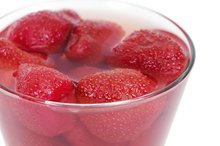How to Eat Raw Onions for a Cold and Stuffy Nose
Onions come from the "Allium" family of plants, with many species consisting of a bulb that grows underground with a vertical stem appearing above ground. A relative of garlic, most onions have a sharp, spicy flavor, although some are sweet and mild. They are used in dishes throughout the world and also medicinally. Onions carry inflammatory and antioxidant chemicals that may act as remedies. One way they are used is to fight colds. Consult your physician before using raw onions for any respiratory illness.
Peel and cut onions, preferably red onions, into thin slices. All onions have medicinal properties and work to treat colds, but red onions have the highest level of quercetin, a flavonoid high in antioxidants that battle free radicals and inhibit histamine production.
Does a Cut-Up Onion Clear Sinuses?
Learn More
Place the onions in a bowl and pour honey over them 1. Use enough honey to coat the slices. This will lessen the severity of the taste or "heat" of the onions and also bring out more of the power of honey as a natural cough suppressant. Some varieties of honey also contain quercetin.
Put the onion slices in a refrigerator to sit overnight and eat them in the morning. Any leftover honey that has been infused with onion properties may also be consumed.
The Effects of Onions on Cholesterol & Blood Sugar
Learn More
Incorporate onions into dishes. Raw onions may be added to soups and sandwiches and many other recipes. Onions may be added to almost any savory dish and some sweet ones. The goal is to ingest as many raw onions as possible to treat your condition without compromising your diet.
Tips
Onions are best consumed raw when fighting a cold and stuffy nose, but cooked onions don't lose many of their nutrients and may also be eaten for health benefits.
Warnings
Onions absorb bacteria when exposed to air and therefore should be kept in a refrigerator.
Related Articles
References
- Onions, raw. FoodData Central. U.S. Department of Agriculture. Published April 1, 2019.
- Anderson GH, Soeandy CD, Smith CE. White vegetables: Glycemia and satiety. Adv Nutr. 2013;4(3):356S-67S. doi:10.3945/an.112.003509
- Exploring aromatics. Academy of Nutrition and Dietetics. Updated 2020.
- Dabeek WM, Marra MV. Dietary quercetin and kaempferol: Bioavailability and potential cardiovascular-related bioactivity in humans. Nutrients. 2019;11(10). doi:10.3390/nu11102288
- Puccinelli MT, Stan SD. Dietary bioactive diallyl trisulfide in cancer prevention and treatment. Int J Mol Sci. 2017;18(8). doi:10.3390/ijms18081645
- Marrelli M, Amodeo V, Statti G, Conforti F. Biological properties and bioactive components of Allium cepa L.: Focus on potential benefits in the treatment of obesity and related comorbidities. Molecules. 2018;24(1). doi:10.3390/molecules24010119
- Chae MR, Kang SJ, Lee KP, et al. Onion (Allium cepa L.) peel extract (OPE) regulates human sperm motility via protein kinase C-mediated activation of the human voltage-gated proton channel. Andrology. 2017;5(5):979-989. doi:10.1111/andr.12406
- Smith AP, Sutherland D, Hewlett P. An investigation of the acute effects of oligofructose-enriched inulin on subjective wellbeing, mood and cognitive performance. Nutrients. 2015;7(11):8887-96. doi:10.3390/nu7115441
- Albanesi M, Pasculli C, Giliberti L, et al. Immunological characterization of onion (Allium cepa) allergy. Postepy Dermatol Alergol. 2019;36(1):98-103. doi:10.5114/ada.2019.82829
- Cooking with onions without crying. University of Nebraska-Lincoln. Updated 2020.
- What is the low FODMAP diet?. Academy of Nutrition and Dietetics. Updated 2019.
- Onions. RxList. Updated 2019.
- Shock CC, Cheatham NE, Harden JL, Mahony, AC, Shock BM. Types of onions and varieties. Oregon State University. College of Agricultural Sciences. Updated 2020.
- Dowdy S. Stored properly Vidalia onions can still be around this winter. University of Georgia. College of Agriculture and Environmental Science. Updated 2019.
Resources









